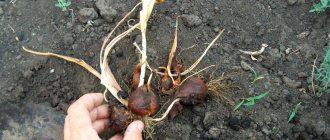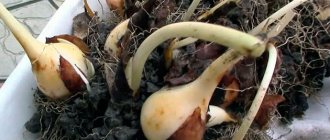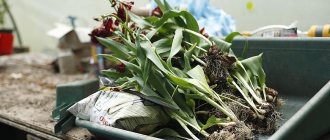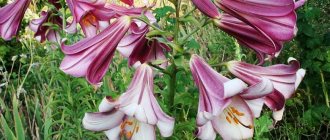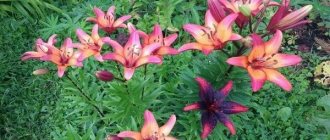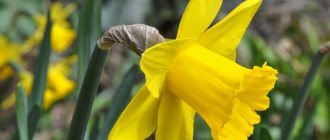Similarities in planting and caring for daffodils and tulips
These flowering crops belong to the bulbous crops. They bloom in spring and are considered one of the earliest flowers. You can often find mixed tulip and narcissus plantings. This is explained by the fact that they have similar requirements for growing conditions, soil moisture, and the presence of minerals in the soil.
Their bulbs must be dug up for the winter and stored until spring. In addition, these crops are affected by the same diseases and pests. Therefore, preventive measures for them can be carried out jointly. The recommended planting dates, as well as the technology for planting in the ground, are the same for bulbous plants.
Tulips
And the frost is not terrible!
Tulips are perhaps the most resilient bulbs you can think of. There is only one thing they can’t stand – getting soaked. And this is not surprising if you consider that even luxurious Dutch varieties continue to preserve the memory of their distant homeland - the steppes, deserts and mountains. And there there are often severe frosts without snow, unstable weather, winds, and drought. But there is plenty of sun! Based on this, you need to choose a place to plant them - it can be windy, with poor rocky soil, but always well lit.
By the way, if you happen to get tulip bulbs that are not too dry in October, November, and even January, take them. They can be planted at any time, as long as the soil can still be shoveled. Or, if the snow has already fallen, you can simply rake it to the ground, lay out the bulbs and sprinkle with any earthen mixture (though you will have to bring it with you). The layer of soil can be quite small - there are many known cases when dug up tulips, thrown on a bed or path, successfully overwintered “naked”.
True, there is one thing. Such “extreme” actions are good when saving plants and preserving the variety is more important than getting perfect flowering in the coming spring. For purely decorative purposes, purchase bulbs selected by size and plant them exactly on time.
When to plant daffodils and tulips
The best time for planting the crops described is autumn - from September to November (depending on climatic and weather conditions). It is important to plan the timing so that the bulbs have time to adapt to the open ground before the onset of cold weather. For example, in the Moscow region, planting should be carried out no later than mid-October. Otherwise, the planting material will freeze and die. The optimal temperature for rooting bulbs is +5...+7°C.
Did you know? For the first time, residents of the Middle Eastern countries began cultivating the tulip. In the 11th century this flower was a symbol of the culture of the Seljuk tribe.
Autumn planting is good because in the spring the plants will produce their first flowers. At other times, for example in summer, it is not worth planting bulbous crops. Their rooting will still occur at the specified temperature, and before it occurs, there is a high risk that the bulbs will be damaged by bacteria or insects. Also, planting material can germinate before the onset of frost, but low temperatures will destroy it.
Video: autumn planting of tulips and daffodils
Results
Properly planted flowers will certainly delight the owner in the spring: daffodils and tulips are the first large flowers to bloom after winter. A very important step is determining the time of planting the bulbs; in order to choose the right date, you need to monitor the weather in the region.
The gardener must also take into account that in frosty and snowless winters, bulbous plants often freeze out, so it is recommended to mulch plantings of daffodils and tulips with a thick layer of peat, leaves, sawdust, and remove this shelter when it gets warmer. Then all the bulbs planted in the fall will sprout, and the flower beds will look neat, without “bald spots.”
Planting and care
The success of growing bulbous crops depends on compliance with the timing and planting technology, as well as on the successful selection of location and planting material. The site for planting should be well-lit, sheltered from drafts and winds from the north. Water should not stagnate on it - in waterlogged soil, plants will get sick, rot and die.
Important! When choosing a place for bulbous plants, you should definitely take into account which predecessors previously grew on it.
Planting after closely related crops, such as hyacinths, crocuses, lilies, increases the risk of infection by diseases and harmful insects. These flowers prefer soil that is fertile, loamy, sandy, well-drained, with a neutral or low acidity level (up to 7.8 pH). It must conduct moisture and air well, and be loose. If the soil on the site does not meet the specified characteristics, it needs to be improved: add coarse river sand (20 kg/m²) to clayey soil, peat or humus (15 kg/m²) to sandy soil, and limestone (200–500 g) to high acidity soil. /m²).
Processing of planting material
The quality of plant flowering directly depends on which bulbs are planted.
Learn about preparing tulips for planting.
When choosing planting material, preference should be given to specimens with the following characteristics:
- dense;
- average in size;
- no mold smell;
- without rotten areas;
- with a dry and dense bottom.
To prevent the development of diseases and damage by harmful insects, before planting, the bulbs must be treated with Vitaras, Maxim (according to the instructions) or kept for half an hour in a solution of potassium permanganate (0.5%).
Landing rules
Before planting plants, it is necessary to prepare the soil on the site. It needs to be cleared of plant residues and dug to a depth of 35–40 cm. It is worth adding a mixture of peat or compost (2 buckets with a volume of 10 l/m²), wood ash (100–150 g/m²), superphosphate (50 g/m²). m²), potassium sulfate (30 g/m²), ammonium nitrate (25 g/m²). If it is not possible to purchase all these components, then you can buy a special mineral complex for bulbous plants at a gardening store.
Important! It is strictly forbidden to introduce fresh manure into the area where you plan to grow bulbous crops. This can cause root burns.
Planting holes should be made 1–2 weeks before planting. Their depth is calculated using the “rule of three”: it should be equal to the height of three bulbs. So, for large specimens it will be 10-20 cm, for small ones - 9-10 cm. The distance between the holes should be 10-20 cm, between the rows - 20-25 cm.
The landing technology is as follows:
- Place a layer of moistened sand 1–2 cm thick on the bottom.
- Place the onions on it with the pointed end up.
- Sprinkle with a layer of earth.
We recommend that you learn how and when to dig up tulips for transplanting to another location.
Step-by-step transplant instructions
There is nothing complicated in the replanting process; even novice flower growers can carry out this procedure. The algorithm of actions is described in detail below:
- Initially, you need to finally decide on the deadline , choosing the most optimal period for this.
- The bulbs are carefully dug out. Daffodils are not afraid of losing root shoots, and this does not affect their viability in any way, but you should try to avoid causing damage to the tubers themselves, as this can lead to diseases, rotting and other processes leading to death. To increase safety, the bulb must be dug around the perimeter and then removed along with a lump of soil. It is best to use a garden fork rather than a shovel for these purposes.
- Dug up bulbs must be manually cleaned of adhering soil and carefully inspected. If traces of any diseases, damage, or activity of rodents or insects are detected, such specimens must be destroyed; it is recommended to burn them immediately.
- Selected bulbs are washed with warm and clean water , after which they are soaked for 30 minutes in a weak solution of potassium permanganate.
- The treated planting material must be placed in containers and placed in a fairly dark place with good ventilation , the most optimal temperature for maintaining is +17°C.
- After the tubers dry quickly, you can move on to planting them in a new place. It is recommended to plant in asymmetrical groups, but if you plan to cut off flowering plants in the future, then planting in even rows will be a more rational solution.
- The degree of deepening usually depends on the dimensions of the planting material, usually it is about 12 cm , but when transplanting into light soil, the depth can be increased to 17 cm. When planting children, the depth should be 10 cm, regardless of other factors.
- Holes for placing bulbs in them are made in advance; a distance of at least 10-12 cm must be maintained between them. Compliance with this indicator allows for fairly dense planting, which will have a positive effect on the development of tubers and a natural increase in their diameter. However, if it is necessary to produce a large number of children, the distance between the holes will need to be increased to 15-20 cm.
- The bulbs placed in the correct position are covered with garden soil on top. If the weather is dry, the first watering at the new location is required.
Flower care
Caring for plants involves carrying out such mandatory procedures as moistening, fertilizing, loosening, weeding, and mulching. The plants described need to be watered regularly, because they are moisture-loving. It is necessary to select an irrigation regime in which the soil is sufficiently moistened, but not flooded. The recommended number of waterings is 3 times per growing season. Water consumption - 50 l/m².
It is necessary to ensure that the soil is moistened to a depth of 30–35 cm after watering. You cannot moisten with cold water, it must be warm.
After each moistening and precipitation, it is worth loosening the soil. This procedure is necessary to prevent the appearance of a dense crust on the surface of the earth. As a result of its implementation, the supply of moisture and air to the bulbs and roots improves. Another mandatory procedure is weeding. It is important to keep the area clean and promptly remove weeds with their roots, as they are carriers of diseases and pests.
Did you know? Flower bulbs were sold very expensively in the Netherlands in
the mid-17th century .
Each of them was more expensive than the house of a person with an average income. To reduce the amount of wetting, loosening and weeding, the soil on the site needs to be mulched. Peat, sawdust, pine needles, and fallen leaves are used as mulch. This procedure allows you to maintain the required level of soil moisture. For long and abundant flowering, plants need fertilizing. Mineral complexes are recommended for these crops.
During the season, 3-4 fertilizer applications will be required during the following periods:
- after emergence or on snow: nitrogen (15 g) + phosphorus (5 g) + potassium (8 g) per m²;
- when reaching a height of 7–10 cm: nitrogen (10 g) + phosphorus (5 g), potassium (8 g) per m²;
- during the budding period (the same as the previous one);
- after flowering: nitrogen (5 g), phosphorus (5 g), potassium (8 g) per m².
Preparing for winter
In regions with warm winters, bulbous plants do not need to be dug up and moved indoors for storage. You can simply hide them. To do this, you need to cut off the stems and leaves, loosen and level the soil. Then you should lay a high layer of mulch from straw, sawdust, and dry leaves. Cover the top with film or special covering material.
The best varieties of daffodils
Of the 22 varieties of daffodils that I grow on my plantation, my favorites are the following.
Yellow Cheerfulness. One of the latest garden varieties. This beauty with small flowers is needed on every plantation. It is very fragrant and lasts in a vase for at least a week.
Orangery. This unusual variety with a white and yellow corolla and a split crown with a carved edge immediately attracts the eye.
Pink Charm. A stunning variety with ivory petals and a delicate peachy pink crown. The most charming of all the pink varieties that we grow, as if straight out of a 16th century Dutch painting: romantic, classic, unique and beautiful.
Petit Four. Of all the daffodils I have ever seen and grown, none compares to this one in beauty and elegance. Its pointed ivory outer petals gracefully frame a double terry crown that combines the most exquisite shades of apricot pink, creamy yellow and peach. If I had to limit myself to just one variety of daffodils, I would choose this one.
Sir Winston Churchill. The thick stems of this multi-flowered variety are topped with dense, double white flowers with a strong aroma.
Tahiti. Bright yellow corrugated petals alternate with red ones in the center of the flower. Thanks to its long, strong stems and large flowers, this variety is perfect for bouquets.
Flower Drift. A beautiful single-flowered variety with a very cheerful combination of overlapping orange and soft ivory petals. A truly unforgettable sight.
Disease Prevention
If mistakes are made during planting and care, or if preventive measures are ignored, the plants begin to get sick.
Read about the rules for processing and storing tulips after digging.
The following measures will help prevent disease and harmful insects:
- thorough cleaning of plant debris from the site in the fall;
- deep autumn digging;
- compliance with planting technology, in particular, planting bulbs at the recommended depth;
- selection of healthy planting material;
- processing of bulbs before planting;
- regular weeding;
- applying the right fertilizers at the right time;
- proper storage;
- preventive spraying.
Video: how to treat flower bulbs before planting
Carrying out all of the above procedures reduces the risk of infection to zero. Planting plants that have insecticidal properties, for example, marigolds, marigolds, nasturtiums, and mustard, in close proximity will also protect flower plantings from pests.
You might be interested in learning how tulips reproduce.
When to dig up tulips and daffodils after flowering
To protect the bulbs from frost and thaw, they need to be dug up before winter. The procedure is planned for the period when flowering is completely completed and the leaves turn yellow. Gently dig up the bulb with a spatula and pull it out by the leaves. Then you need to remove the foliage and remaining soil. Before storing, the bulb must be dried in a warm place where the sun's rays do not penetrate. After this, the children are separated and culled.
Since neither tulips nor daffodils can grow in one place for longer than 3-5 years, after this period they need to be replanted. The transplant should be planned for mid-September - mid-October.
How to store before planting
Immediately before storing the bulbs, you need to soak them for a quarter of an hour in a solution of potassium permanganate. This will disinfect them and reduce the risk of contracting diseases. The bulbs should be stored in a room where the temperature is maintained close to zero, there is good air circulation, and where the rays of the sun do not pass through.
Did you know? Narcissus is the symbol of the Chinese New Year.
If it blooms before this date, it is believed to be a good sign that will ensure happiness in the coming year. A cellar is suitable for storage. Planting material is stored here in wooden boxes with a light soil substrate (for example, a mixture of peat and sawdust). You can also place the bulbs 2 months before spring in the refrigerator. Starting in the fall, they cannot be stored in such conditions, since they will sprout before planting.
Thus, planting and caring for closely related plants such as tulip and daffodil have much in common. These crops can be planted at the same time. In order for them to decorate the site for a long time, it is important to choose the right place and provide high-quality care in accordance with the recommendations.
What to do with small tulip bulbs
Tulip bulbs should be stored in a warm room until autumn planting, and small bulbs - baby tulips - on the contrary, should be stored in a cool place, otherwise they dry out very quickly and may dry out completely. It is important to ensure protection from mice and periodically check the bulbs. At the beginning of August, baby tulips can be planted for growing - in a school or in a garden bed. If you do not have the opportunity to store small bulbs separately, you can plant them immediately - then do not forget to water and weed the plants.
